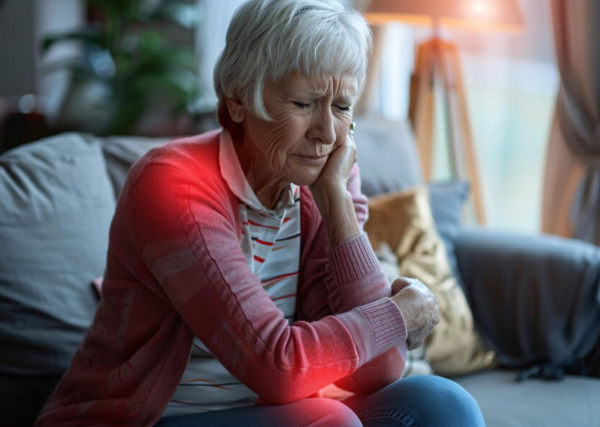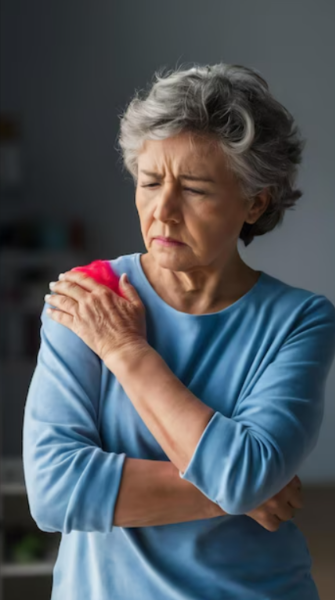Menopause marks a significant phase in a woman’s life, signifying the end of her reproductive years. While it is a natural biological process, menopause brings a host of physical and emotional changes, many of which can be challenging.
One common complaint among women undergoing menopause is joint pain. This article explores the link between menopause and joint discomfort, examining the causes, symptoms, and potential remedies to help women manage this often-overlooked aspect of menopause.
Yes, menopause can cause joint pain due to hormonal changes, particularly the drop in estrogen, which affects joint health and inflammation levels.

What is Menopause?
Menopause typically occurs between the ages of 45 and 55 and is defined by the cessation of menstrual periods for 12 consecutive months.
This transition period, known as perimenopause, can last several years and is characterized by fluctuating hormone levels, particularly estrogen.
Estrogen plays a crucial role in various bodily functions, including maintaining bone density, regulating mood, and influencing skin elasticity.
As estrogen levels decline during menopause, women may experience a range of symptoms, including hot flashes, night sweats, mood swings, and sleep disturbances.
The Connection Between Menopause and Joint Pain
Joint pain, also known as arthralgia, is a common complaint during menopause. Many women report experiencing aches and stiffness in their joints, particularly in the hands, knees, and hips.
While the exact cause of this joint pain is not entirely understood, several factors contribute to the development of joint discomfort during menopause.
1. Hormonal Changes
The most significant factor linking menopause to joint pain is the decline in estrogen levels. Estrogen has anti-inflammatory properties and helps to maintain healthy cartilage, which cushions the joints.
As estrogen levels decrease, the protective effect diminishes, making joints more susceptible to inflammation and wear and tear. This can lead to conditions such as osteoarthritis, where the cartilage that protects the joints breaks down, causing pain and stiffness.
2. Decreased Bone Density
Menopause is also associated with a decrease in bone density, a condition known as osteoporosis. Estrogen is crucial for maintaining bone strength, and its decline during menopause can lead to bone thinning.
Weakened bones are more prone to fractures and can contribute to joint pain, particularly in weight-bearing joints like the knees and hips.
3. Weight Gain
Many women experience weight gain during menopause due to a combination of hormonal changes and a slower metabolism. Excess weight puts additional stress on the joints, particularly in the knees and hips, exacerbating joint pain.
Additionally, fat cells produce inflammatory chemicals called cytokines, which can further contribute to joint inflammation and discomfort.
4. Lifestyle Factors
During menopause, lifestyle factors such as diet, exercise, and stress management can significantly impact joint health. A sedentary lifestyle, poor nutrition, and high stress levels can exacerbate joint pain.
Lack of physical activity leads to stiffness and decreased flexibility, while a diet low in essential nutrients like calcium and vitamin D can weaken bones and joints.
Symptoms of Menopausal Joint Pain
Joint pain during menopause can manifest in various ways, depending on the individual and the severity of hormonal changes. Common symptoms include:
- Aching or Stiffness: Women may experience persistent aches in their joints, particularly in the morning or after periods of inactivity. Stiffness is common in the hands, knees, shoulders, and hips.
- Swelling: Inflammation can cause swelling around the affected joints, making them tender to the touch.
- Reduced Range of Motion: Joint pain can lead to a decreased range of motion, making it difficult to perform everyday tasks such as bending, lifting, or gripping objects.
- Fatigue: Chronic joint pain can lead to fatigue, as the body expends energy to cope with discomfort. This can contribute to feelings of overall tiredness and decreased motivation.

Managing Menopausal Joint Pain
While menopausal joint pain can be challenging, several strategies can help alleviate discomfort and improve quality of life.
Managing joint pain during menopause often requires a multifaceted approach that includes lifestyle changes, dietary adjustments, and medical interventions.
1. Hormone Replacement Therapy (HRT)
Hormone Replacement Therapy (HRT) is a common treatment for managing menopausal symptoms, including joint pain. HRT involves supplementing the body with estrogen to counteract the decline in hormone levels.
By restoring estrogen levels, HRT can reduce inflammation, improve bone density, and alleviate joint discomfort.
However, HRT is not suitable for everyone and may carry certain risks, so it’s essential to discuss the benefits and potential side effects with a healthcare provider.
2. Physical Activity
Regular exercise is crucial for maintaining joint health and reducing pain during menopause.
Low-impact activities such as walking, swimming, yoga, and cycling can help strengthen the muscles around the joints, improve flexibility, and reduce stiffness.
Weight-bearing exercises like resistance training can also enhance bone density and prevent osteoporosis. It’s important to start slowly and gradually increase the intensity of workouts to avoid overexertion and injury.
3. Anti-Inflammatory Diet
Diet plays a vital role in managing joint pain during menopause. An anti-inflammatory diet rich in fruits, vegetables, whole grains, lean proteins, and healthy fats can help reduce inflammation and support overall joint health.
Foods high in omega-3 fatty acids, such as fatty fish (salmon, mackerel), flaxseeds, and walnuts, have been shown to reduce joint inflammation.
Additionally, incorporating sources of calcium and vitamin D, such as dairy products, leafy greens, and fortified foods, can support bone health.
4. Supplements
Certain supplements may help alleviate menopausal joint pain by providing essential nutrients that support joint and bone health. Common supplements include:
- Calcium and Vitamin D: These nutrients are crucial for maintaining strong bones and preventing osteoporosis.
- Glucosamine and Chondroitin: These supplements are often used to support joint health and may help reduce the symptoms of osteoarthritis.
- Omega-3 Fatty Acids: Found in fish oil supplements, omega-3s have anti-inflammatory properties that can help reduce joint pain.
- Turmeric (Curcumin): Turmeric is a natural anti-inflammatory that may help alleviate joint pain and stiffness.
Before starting any supplement regimen, it’s important to consult with a healthcare provider to ensure safety and efficacy.
5. Stress Management
Stress can exacerbate joint pain by increasing inflammation and muscle tension. Managing stress through relaxation techniques, such as deep breathing, meditation, and mindfulness, can help reduce pain and improve overall well-being.
Regular physical activity, adequate sleep, and engaging in hobbies or activities that bring joy can also help manage stress levels during menopause.
6. Medications
In addition to HRT, several medications can help manage joint pain during menopause. Over-the-counter nonsteroidal anti-inflammatory drugs (NSAIDs), such as ibuprofen and naproxen, can reduce inflammation and relieve pain.
For more severe pain, a healthcare provider may prescribe stronger pain relievers or medications specifically designed to treat osteoporosis or arthritis.
When to See a Doctor
While joint pain during menopause is common, it’s important to consult a healthcare provider if the pain is severe, persistent, or significantly impacts daily life.
A doctor can help determine the underlying cause of the pain and recommend appropriate treatments. In some cases, joint pain may be a sign of an underlying condition, such as rheumatoid arthritis or an autoimmune disorder, which requires specialized care.
Conclusion
Menopause is a natural part of aging, but it can bring about a range of symptoms, including joint pain. The decline in estrogen levels during menopause can lead to inflammation, decreased bone density, and joint discomfort.
However, by understanding the connection between menopause and joint pain, women can take proactive steps to manage their symptoms and maintain their quality of life.
Through a combination of lifestyle changes, dietary adjustments, and medical interventions, it’s possible to reduce joint pain and enjoy a healthier, more comfortable transition into this new phase of life.
If joint pain becomes unmanageable, seeking medical advice is crucial to ensuring that the appropriate care is provided.
Related Articles:
.
